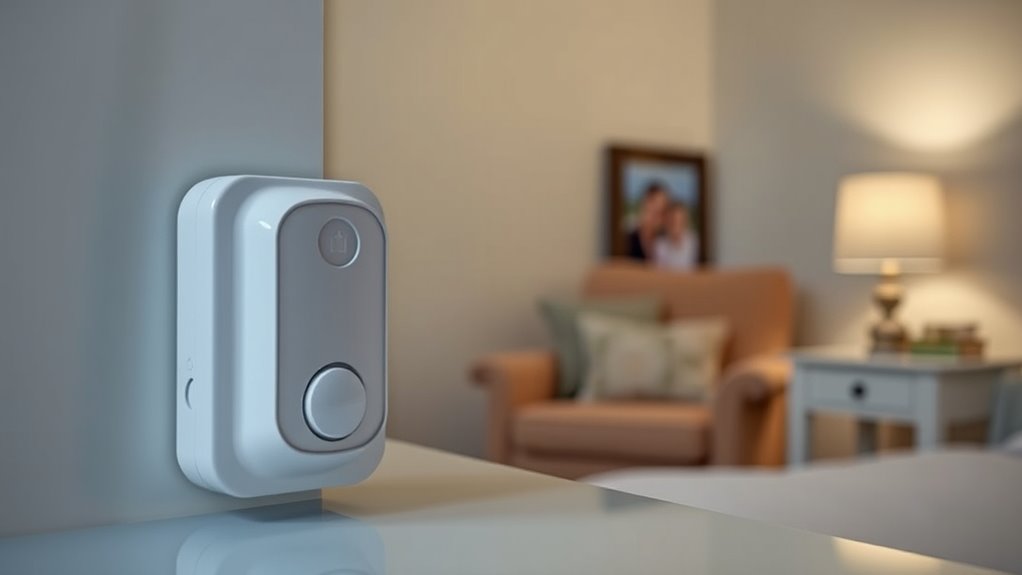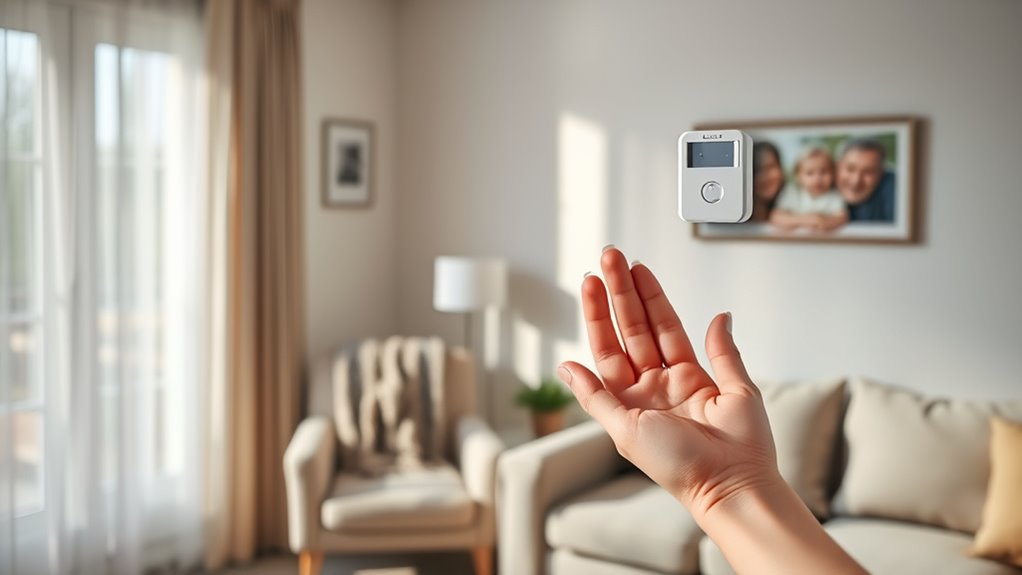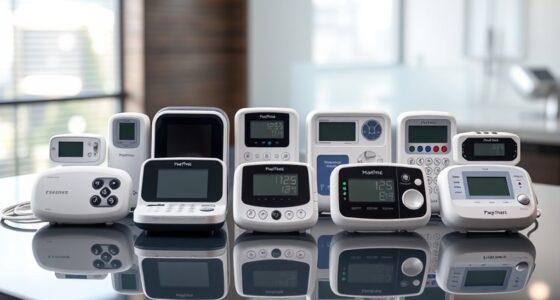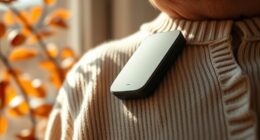If you’re looking for the best motion sensor alarms for dementia patients, I’ve got some great options for you. Devices like the CallToU Wireless Motion Sensor Alarm and the EverNary Caregiver Pager are designed to enhance safety and provide peace of mind. They offer customizable alerts and easy installation, making them perfect for monitoring movement indoors. You’ll find solutions tailored to your needs. Stick around to discover even more effective choices for keeping your loved ones safe.
Key Takeaways
- Indoor motion sensor alarms, like the CallToU and Bed Sensor Alarms, are designed to enhance safety for dementia patients by detecting movement effectively.
- Systems offer extensive coverage, with ranges up to 1000 feet, ensuring monitoring of multiple rooms and entry points in large homes.
- Customizable alerts, including loud alarms and silent modes, help tailor notifications to individual needs while minimizing alarm fatigue for caregivers.
- Easy installation and wireless operation allow for quick setup without complex wiring, ensuring devices can be placed where needed most.
- Expandable systems accommodate up to 20 sensors, allowing comprehensive monitoring and peace of mind for caregivers managing dementia patients.
CallToU Wireless Motion Sensor Alarm for Indoor Use
If you’re looking for a reliable solution to guarantee the safety of dementia patients in your home, the CallToU Wireless Motion Sensor Alarm is an excellent choice. I’ve found its two sensors and one receiver incredibly effective for indoor safety. With a wireless range of 500 ft, I can place sensors under beds or by doors to monitor movement and prevent falls. The adjustable volume and 33 ft detection distance ensure I get timely alerts without overwhelming noise. Plus, the easy setup and self-test feature make it user-friendly. It truly eases my worries, allowing me to care for my loved ones more confidently.
Best For: The CallToU Wireless Motion Sensor Alarm is best for caregivers and families looking to ensure the safety of elderly individuals, particularly those with dementia.
Pros:
- Easy installation with pre-programmed sensors and a simple plug-and-play receiver.
- Adjustable volume settings and a 33 ft detection distance provide customizable alerts without being overwhelming.
- Long wireless range of 500 ft allows flexible placement throughout large residences for comprehensive monitoring.
Cons:
- Limited to indoor use, which may not suit those needing outdoor monitoring solutions.
- May require occasional battery replacements for sensors, which can be inconvenient.
- Detection capabilities are primarily focused on movement; it may not detect other safety concerns like medical emergencies.
Upgraded Bed Sensor Alarm and Fall Prevention for Elderly
The Upgraded Bed Sensor Alarm is an essential tool for caregivers of elderly dementia patients, as it effectively monitors their movements to prevent falls. I love how the wireless motion sensors can be discreetly placed under beds or at doors, alerting me when my loved one gets up. With features like a caregiver pager, multiple volume levels, and an impressive range of 918 feet, I feel secure knowing I’ll be notified promptly. The dual reminder system with LED lights and sound helps minimize startling alarms, creating a calmer environment. This system is reliable, easy to install, and truly enhances safety for my family.
Best For: Caregivers of elderly individuals, particularly those with dementia, who need reliable monitoring to prevent falls.
Pros:
- Wireless motion sensors allow for discreet placement, enhancing safety without being intrusive.
- Multiple volume levels and a dual reminder system help create a calmer environment, minimizing startling alerts.
- Impressive range of 918 feet ensures caregivers are notified promptly, even from a distance.
Cons:
- Initial setup may require testing and calibration for optimal performance.
- Battery reliance could lead to maintenance concerns if not monitored regularly.
- Limited to indoor use, which may not address all potential safety concerns in various environments.
EverNary Wireless Caregiver Pager Motion Sensor Alarm for Home and Elderly
Looking for a reliable way to monitor your loved ones, especially those with dementia? The EverNary Wireless Caregiver Pager Motion Sensor Alarm is a fantastic choice. It comes with a plug-in receiver and a motion sensor that detects movement within 16.4 feet. With a signal range of up to 500 feet outdoors, this system offers flexibility and reliability. You’ll appreciate the 58 customizable ringtones and adjustable volume levels, ensuring alerts fit your needs. Installation is a breeze with battery or USB options, plus an adjustable mounting bracket. It’s perfect for keeping an eye on entry points and ensuring safety at home.
Best For: Those seeking reliable monitoring solutions for elderly loved ones, particularly individuals with dementia or mobility challenges.
Pros:
- Customizable Alerts: Offers 58 ringtones and adjustable volume levels to cater to individual needs.
- Flexible Installation: Can be powered by batteries or USB, and includes an adjustable mounting bracket for easy placement.
- Wide Detection Range: Detects motion up to 16.4 feet and has a transmission range of up to 500 feet outdoors, ensuring comprehensive coverage.
Cons:
- Limited Indoor Range: Signal transmission indoors may only reach 10-50 meters depending on obstacles, which may affect usability in larger homes.
- Battery Dependency: Although it can be powered by USB, reliance on batteries may require regular replacements, adding maintenance.
- Single Motion Sensor Included: Additional sensors may need to be purchased separately for wider coverage in multiple areas.
CallToU Wireless Motion Sensor Alarm for Indoor Use
Designed specifically for indoor safety, the CallToU Wireless Motion Sensor Alarm stands out as an ideal choice for dementia patients and their caregivers. This system includes two sensors and one receiver, providing reliable alerts within a 500FT range. I love how easy it is to set up—just plug in the receiver, and it performs a self-test. The sensors detect motion within a 33FT range, perfect for monitoring exits or alerting me when my loved one is getting up. With adjustable volume levels, I can customize the alarm to suit our home environment, ensuring peace of mind and safety.
Best For: The CallToU Wireless Motion Sensor Alarm is best for caregivers of elderly individuals, especially those with dementia, who need to monitor their movements for safety.
Pros:
- Easy setup with plug-and-play installation and self-testing feature.
- Adjustable volume levels for customized alerts in various environments.
- Wide detection range of 33FT minimizes false alarms and enhances monitoring capabilities.
Cons:
- Limited to indoor use, which may not suit all monitoring needs.
- Potential interference from other wireless devices in densely populated areas.
- Requires battery replacements for sensors, which may add to maintenance efforts.
Bed Alarms for Elderly Dementia Patients – Digital Sensor ID Display & Caregiver Pager
For caregivers seeking a reliable solution to monitor elderly dementia patients, the innovative bed alarm system stands out with its digital sensor ID display feature. This system utilizes infrared motion sensors to detect footstep movement, minimizing false alarms from bed shifts. With a 1000-foot wireless range and the ability to expand to multiple sensors, I can guarantee full-home coverage. The caregiver pager offers five alert modes and a rechargeable battery lasting 1-3 months. Best of all, there are no monthly fees, providing peace of mind while respecting privacy. It’s an essential tool for any caregiver dedicated to safety.
Best For: Caregivers of elderly dementia patients who need a reliable and non-intrusive monitoring solution.
Pros:
- Innovative design minimizes false alarms with infrared motion sensors while ensuring accurate footstep detection.
- Expandable system allows for up to 20 sensors and unlimited receivers, providing comprehensive coverage throughout the home.
- Privacy protection with non-contact motion detection and no monthly fees, ensuring alerts are local and personal data remains secure.
Cons:
- Battery dependency for sensors and pager may require regular recharging or battery replacement.
- Limited to movement detection, which may not cover all potential safety issues for dementia patients.
- Installation may require careful placement to avoid false triggers from pets or other movements.
Wireless Motion Sensor Door Chime for Business Entry
A standout feature of the Wireless Motion Sensor Door Chime is its ability to alert caregivers when movement is detected, making it an excellent choice for monitoring dementia patients. With 32 unique ringtones and adjustable volume levels up to 110dB, you can customize alerts to fit your environment. The system’s impressive range detects movement from 16-26 feet away and transmits signals up to 500 feet, ensuring all-encompassing coverage. Plus, the visual LED indicator is a great addition for those who are hearing impaired. This device not only enhances safety for seniors but also benefits businesses by monitoring customer and staff activity effectively.
Best For: Caregivers monitoring dementia patients and business owners needing to track customer and staff movement effectively.
Pros:
- 32 unique ringtones allow for customizable alerts to suit various environments and preferences.
- Adjustable volume levels up to 110dB cater to different hearing needs, including a silent mode option.
- Expandable system supports up to 20 sensors and unlimited receivers, providing comprehensive coverage for larger areas.
Cons:
- Limited to indoor use may not be suitable for outdoor monitoring without additional protective measures.
- Motion sensor requires batteries (2 AAA included), which may need regular replacement to maintain functionality.
- Installation may require tools for mounting, which could be a barrier for some users.
Wireless Bed Alarms for Elderly with Motion Sensor & Caregiver Pager
If you’re caring for an elderly loved one with dementia, the wireless bed alarms featuring motion sensors and caregiver pagers can be a lifesaver. These alarms use infrared sensors to detect foot movement, reducing false alarms caused by bed shifts. The caregiver pager helps identify the alert source quickly, and with five alert modes, you can choose vibrations or chimes that suit your needs. The system works over a 1,000-foot range, making whole-home monitoring easy. Plus, there are no monthly fees, and it’s simple to install. This solution provides peace of mind while ensuring your loved one’s safety.
Best For: Caregivers of elderly dementia patients seeking an effective and reliable monitoring solution that minimizes false alarms.
Pros:
- Reduces false alarms by detecting foot movement instead of bed shifts, ensuring accurate alerts.
- Wide coverage with a range of up to 1,000 feet, allowing for comprehensive monitoring throughout the home.
- No monthly fees and straightforward installation, making it a cost-effective and user-friendly solution.
Cons:
- Limited to motion detection, which may not capture all incidents if the patient is not moving.
- Battery dependency for sensors may require regular checks and replacements, adding to maintenance.
- Expandable system may incur additional costs if extra sensors or receivers are needed for larger homes.
Bed Alarm for Elderly Adults Wireless and Fall Prevention Sensor
The Bed Alarm for Elderly Adults, featuring a wireless fall prevention sensor, stands out as an ideal choice for caregivers monitoring dementia patients. With a range of 918 feet, I can easily keep tabs on my loved ones whether they’re getting out of bed or moving around the home. The upgraded alert system, with adjustable tones and vibration options, guarantees I never miss a signal. Plus, the setup is a breeze—just place the sensor and switch it on. This device not only prevents falls but also offers peace of mind, making it a must-have for those caring for elderly adults.
Best For: Caregivers monitoring elderly adults, especially those with dementia, who need reliable fall prevention and mobility alerts.
Pros:
- Wireless long-range monitoring allows caregivers to keep track of loved ones from a distance of up to 918 feet.
- Adjustable alert system provides customizable tones and vibration options, ensuring alerts can be tailored to individual needs.
- Easy setup and use with factory pairing and simple placement makes it accessible for caregivers and family members.
Cons:
- Battery dependency may require regular monitoring and replacement, which can be inconvenient.
- Limited to monitoring specific areas, as the sensor must be strategically placed either under the bed or in doorways.
- Potential for false alarms if the sensor is not properly positioned, despite low occurrence.
CallToU Wireless Motion Sensor Alarm for Indoor Use
Designed specifically for indoor use, the CallToU Wireless Motion Sensor Alarm is an ideal choice for families caring for dementia patients. I appreciate how it can be placed under beds or at doors to monitor movement effectively. The setup is a breeze—just plug it in, and it’s ready to go. With a 33-foot detection range and a wireless reach of up to 500 feet, I feel confident knowing I’ll receive timely alerts. Plus, the five volume levels allow me to customize notifications based on my environment. This alarm truly offers peace of mind for both caregivers and loved ones.
Best For: Families caring for elderly individuals or dementia patients who need reliable indoor monitoring and alerts.
Pros:
- Easy setup with pre-programmed features, allowing immediate use.
- Impressive detection range of 33 feet and wireless transmission range of up to 500 feet.
- Adjustable volume levels provide customization for different environments.
Cons:
- Limited to indoor use, which may not suit all monitoring needs.
- Requires a power outlet for operation, potentially limiting placement options.
- Performance may vary in cluttered or obstructed environments, affecting detection reliability.
WiFi Smart Bed Sensor Alarm for Seniors
For caregivers looking after seniors or dementia patients, the WiFi Smart Bed Sensor Alarm stands out as a crucial tool for ensuring safety and independence. I love how it detects motion and sends instant alerts to my smartphone, no matter where I am. The range is impressive, working indoors up to 150 feet. I can easily place the sensor under the bed or on doorframes to monitor movements effectively. Plus, I can share alerts with family members through the Smart Life app, making caregiving a team effort. This device truly simplifies my monitoring tasks and brings me peace of mind.
Best For: Caregivers looking after seniors or dementia patients who need a reliable monitoring solution for safety and independence.
Pros:
- Instant alerts sent to smartphones regardless of location, ensuring prompt assistance.
- Easy to install with flexible placement options under beds or on doorframes for effective monitoring.
- Supports multiple users through the Smart Life app, enhancing collaborative caregiving efforts.
Cons:
- Limited to 2.4GHz Wi-Fi networks, which may not be compatible with all home setups.
- Indoor range can vary significantly, with a maximum distance of 150 feet depending on obstacles.
- Requires a single phone to connect directly to the hub, which may limit immediate access for multiple caregivers.
Bed Alarm Caregiver Pager with Wireless Motion Sensors for Elderly Monitoring
When caring for dementia patients, having a reliable monitoring system is essential, and the Bed Alarm Caregiver Pager with Wireless Motion Sensors stands out as an excellent choice. Its compact design allows me to place it virtually anywhere—on walls, doorways, or flat surfaces—thanks to its versatile mounting options. With two wireless motion sensors that operate up to 500 feet, I can monitor movements without being tethered. The portable pager fits easily in my pocket, providing discreet alerts. Plus, I can choose between silent notifications or louder alarms, ensuring I respond quickly to keep my loved ones safe and secure.
Best For: The Bed Alarm Caregiver Pager with Wireless Motion Sensors is best for caregivers of elderly individuals and dementia patients who require reliable monitoring and fall prevention.
Pros:
- Flexible installation options allow for easy placement in various locations, enhancing convenience for caregivers.
- Wireless motion sensors provide a wide range of operation (up to 500 feet), ensuring caregivers can monitor movements without being restricted.
- Portable and discreet pager offers silent alerts or loud chimes, allowing caregivers to respond quickly without disturbing residents.
Cons:
- Battery dependency may require regular checks and replacements, leading to potential interruptions in monitoring.
- Wireless range limitations in obstructed areas could affect the reliability of alerts in certain environments.
- Initial setup may require some effort, particularly if mounting the sensors in specific locations is necessary.
Bed Sensor Alarm and Fall Prevention for Elderly
A wireless bed sensor alarm stands out as an essential tool for caregivers looking after elderly individuals or dementia patients, as it promptly alerts them when a loved one gets out of bed. I appreciate how these devices utilize motion sensors placed under the bed or at doorways, minimizing false alarms. The alarm features multiple alerts, including loud sounds and silent modes, ensuring I can respond without disturbing others. With a range of 500 feet, it’s perfect for various settings. Plus, the compact design and 1-year support guarantee peace of mind while keeping my loved ones safe from falls.
Best For: Caregivers looking after elderly individuals or dementia patients who need fall prevention and safety monitoring.
Pros:
- Multiple alert options including loud alarms, LED flash, and vibration modes cater to different caregiver needs.
- Effective range of 500 feet allows for monitoring in larger homes or care facilities without losing connection.
- Compact and portable design with a long-lasting rechargeable battery ensures convenience and reliability.
Cons:
- Initial setup may require careful placement of sensors to minimize false alarms.
- Dependence on battery life means regular charging is necessary to maintain functionality.
- Potential for false alarms from non-fall-related movements, such as incontinence or displacement.
Rechargeable Wireless Bed Alarm for Elderly Dementia Patients
Designed specifically for elderly dementia patients, the Rechargeable Wireless Bed Alarm offers peace of mind to caregivers by accurately detecting when someone is about to exit their bed. I appreciate how it uses motion-activated infrared sensors to sense a foot nearing the ground, reducing false alarms from simple movements. Setting it up is a breeze—just turn on the power, and it’s ready to go. With rechargeable batteries and low battery alerts, I don’t have to worry about replacements. Plus, the customizable sound and light options let me choose the alerts that work best for my loved one’s needs.
Best For: The Rechargeable Wireless Bed Alarm is best for caregivers of elderly dementia patients, sleepwalkers, and individuals needing assistance with bed exit.
Pros:
- Accurate motion detection minimizes false alarms, ensuring reliable alerts.
- Easy installation and setup process, allowing for quick use without complicated configurations.
- Rechargeable batteries with low battery alerts eliminate the inconvenience of frequent replacements.
Cons:
- The device may require periodic recharging, which could be a concern for constant monitoring.
- Limited range of wireless connectivity may not be suitable for larger homes.
- Some users may find the volume of alerts too loud or the selection of tones insufficient for their preferences.
Caregiver Pager Door Alarms for Dementia Patients and Home Security
For caregivers looking to enhance the safety of dementia patients, the caregiver pager door alarms provide an invaluable solution with their impressive 260-foot detection range. These wireless door sensors alert you when doors or windows are opened, ensuring you stay informed about your loved one’s movements. With 58 ringtones and adjustable volume levels, it’s easy to customize notifications to your preference. The built-in LED indicator is a fantastic feature for hearing-impaired users. Plus, the simple plug-and-play installation makes it hassle-free. This expandable system can support multiple sensors, providing thorough coverage for peace of mind in your home security.
Best For: Caregivers seeking to enhance the safety and monitoring of dementia patients and elderly individuals at home.
Pros:
- Wide detection range of 260 feet, allowing caregivers to monitor movements effectively.
- Customizable notifications with 58 ringtones and adjustable volume levels, catering to various preferences.
- Easy installation with plug-and-play setup and expandable system supporting multiple sensors.
Cons:
- Battery-powered sensors may require regular battery replacements, adding to maintenance.
- Limited range may not cover larger homes without additional sensors.
- Potential for false alarms if not properly calibrated or positioned.
CallToU Wireless Motion Sensor Alarm for Seniors
One standout feature of the CallToU Wireless Motion Sensor Alarm is its ability to monitor both bed exits and doorways, making it ideal for dementia patients who may wander at night. I love how it can be placed under the bed to detect movement, alerting me if my loved one tries to get up. With a 33-foot detection range and a 500-foot wireless signal, I can relax knowing I’ll receive timely notifications anywhere in the house. The portable pager’s adjustable volume and vibration options allow me to customize alerts, ensuring I’m always informed without overwhelming distractions. It’s a game changer for caregiver peace of mind.
Best For: The CallToU Wireless Motion Sensor Alarm is best for caregivers of elderly individuals, especially those with dementia, who need reliable monitoring to ensure safety and prevent wandering.
Pros:
- Versatile Monitoring: Can be used for both bed exits and doorways, enhancing safety for seniors.
- Customizable Alerts: Offers adjustable volume and vibration options on the portable pager for personalized notifications.
- Extended Range: Reliable wireless signal of up to 500 feet, allowing caregivers to monitor their loved ones from anywhere in the house.
Cons:
- Potential False Alarms: Although designed to minimize false alarms, some may still occur due to environmental factors like sunlight or wind.
- Limited Detection Range: The motion sensor has a maximum detection range of 33 feet, which may not cover larger rooms or spaces effectively.
- Dependency on Batteries: Requires batteries for both the sensor and pager, which need to be monitored and replaced regularly.
Factors to Consider When Choosing Motion Sensor Alarms for Dementia Patients

When selecting a motion sensor alarm for a dementia patient, I think it’s crucial to consider several key factors. These include the wireless range, detection efficiency, and alert customization options. Plus, ease of installation and power source choices can make a big difference in how user-friendly the system is.
Wireless Range and Coverage
Choosing the right motion sensor alarm requires careful consideration of its wireless range and coverage, especially for dementia patients. I recommend looking for an alarm with a wireless range that covers your entire home, typically between 100 to 1000 feet, depending on your space. It is essential to verify the system uses reliable signal transmission technologies like FHSS or FSK to avoid interference. If your home is larger or has multiple rooms, consider a system that allows for additional sensors or receivers to enhance coverage. Don’t forget to check the detection range and angle of the sensors, ensuring they monitor key areas like doorways and exits effectively, without any blind spots. Finally, verify the system works well in your home’s environment.
Detection Technology Efficiency
Understanding the efficiency of detection technology is crucial for selecting the best motion sensor alarms for dementia patients. I find that infrared motion sensors are particularly effective, as they detect body heat and movement, ensuring reliable alerts. In contrast, contact-based sensors, like floor mats or door sensors, only trigger alarms upon physical contact, which helps reduce false positives. It’s important to contemplate the detection range of these devices, typically between 16 to 33 feet, as it impacts monitoring coverage. Additionally, advanced sensors use algorithms to minimize false alarms from pets or environmental factors. Lastly, I appreciate wireless connectivity with secure signal transmission, ensuring consistent alerts without interference, often over distances of 500 feet or more.
Alert Modes and Customization
Efficient detection technology is just one piece of the puzzle; the alert modes and customization options of motion sensor alarms play a significant role in their effectiveness for dementia patients. I’ve found that having multiple alert modes—like sound, vibration, LED flashes, or silent notifications—can really cater to different caregiver needs. Customizable volume levels, ranging from silent to 120dB, let us tailor alerts to fit various environments and preferences. I love that I can select different alert tones to enhance recognition and reduce alarm fatigue. Plus, the ability to set multiple alert modes at once ensures timely responses to movements while keeping the atmosphere calm, which is vital for avoiding distress in those with dementia.
Installation and Setup Ease
While selecting a motion sensor alarm for a dementia patient, I always prioritize installation and setup ease. I look for alarms that offer simple, tool-free installation, like adhesive mounts or easy screw-in brackets. A straightforward setup process is essential, so I prefer systems with pre-programmed sensors and minimal wiring. Having clear instructions or visual indicators, such as self-test features or LED lights, helps confirm that everything’s working correctly. I also appreciate devices that allow quick calibration or testing of the detection range before final placement. Ultimately, I choose alarms that provide flexible placement options—under beds, at doorways, or on walls—without needing technical expertise, making it easier for everyone involved.
Power Source Options
Choosing the right power source for motion sensor alarms is essential because it directly affects their usability and installation options. I’ve found that motion sensors can be powered by batteries, rechargeable batteries, or direct AC power. Battery-powered sensors often need frequent replacements, which can be a hassle over time. On the other hand, rechargeable options cut down on ongoing costs and are better for the environment. Plus, those with USB connectivity allow for easy recharging, ensuring they stay operational without the need to remove batteries. The choice of power source also influences where you can place the device; some need to be near outlets, while others can be installed wirelessly in various locations, offering much-needed flexibility.
Privacy and Data Security
When it comes to selecting motion sensor alarms for dementia patients, privacy and data security are essential considerations. I always look for devices that avoid using audio, video, or cloud storage, as these can compromise personal data. Opting for local alert systems that don’t share data minimizes risks of breaches and unauthorized access.
I prefer devices with secure wireless communication protocols, like FHSS or encrypted signals, to prevent hacking. Non-contact sensors that merely detect movement without recording images or sounds are also critical for maintaining confidentiality. Finally, I make certain that any product I consider has clear privacy policies and gives users control over data collection and storage. This way, I can safeguard my loved one’s personal information effectively.
Expandability and Compatibility
Considering privacy and data security is important, but I also pay attention to how expandable and compatible the motion sensor alarm system is. I look for systems that support multiple sensors and receivers, allowing me to adapt as care needs evolve. It’s essential to verify that the system integrates seamlessly with existing home automation or smart devices, guaranteeing centralized control. I want to choose a system that allows for easy addition of new sensors without complex reprogramming. Checking compatibility in terms of wireless protocols helps prevent connectivity issues, which is critical for reliable monitoring. Ultimately, evaluating the system’s expandability features ensures it aligns with my long-term safety and monitoring requirements for dementia patients, giving me peace of mind.
Frequently Asked Questions
How Do Motion Sensor Alarms Help Dementia Patients Specifically?
Motion sensor alarms help dementia patients by providing immediate alerts when they wander or move in ways that could indicate distress. I’ve seen how these alarms can enhance safety, allowing caregivers to respond quickly and prevent potential accidents. They give me peace of mind, knowing I’ll be notified if someone needs assistance. Plus, they promote independence for patients, allowing them to explore their environment while still being monitored effectively.
What Is the Average Battery Life of These Alarms?
The average battery life of motion sensor alarms usually ranges from six months to two years, depending on the model and usage. I’ve found that some alarms with lithium batteries tend to last longer, while others might need more frequent replacements. It’s essential to verify the specifications when choosing one. I always keep spare batteries on hand to ensure everything runs smoothly without interruptions. Staying prepared makes a big difference!
Are Motion Sensor Alarms Easy to Install?
Yes, motion sensor alarms are generally easy to install. I’ve set up a few myself, and it usually takes just a few minutes. Most come with adhesive strips or mounting hardware, so you don’t need any special tools. I just followed the instructions, placed them at strategic locations, and tested them. It’s straightforward, and I felt a sense of relief knowing I had added an extra layer of security to my home.
Can These Alarms Be Connected to Smartphones?
Absolutely, these alarms can connect to smartphones! Imagine the peace of mind you’d feel, knowing you can monitor your loved ones from anywhere. It’s like having a personal guardian angel right in your pocket! With real-time alerts sent straight to your phone, you won’t miss a thing. I love how technology makes it easier to stay connected and guarantee safety, giving us that extra layer of comfort we all crave.
What Are the Privacy Concerns With Using Motion Sensors?
I understand your concerns about privacy with motion sensors. They can track movements, potentially leading to unintentional data collection. I worry about how this information might be shared or accessed without consent. Additionally, if the sensors are connected to the internet, there’s always a risk of hacking. It’s vital to read the privacy policy and guarantee that any device I choose prioritizes data protection and user confidentiality. Always stay informed!
Conclusion
In the delicate journey of caring for dementia patients, choosing the right motion sensor alarm can feel like finding a lighthouse in a storm. These devices not only enhance safety but also provide peace of mind for both caregivers and loved ones. By investing in the best options available, you’re not just purchasing a product; you’re embracing a commitment to safety and compassion. So, why wait? Let’s take that step towards a safer tomorrow together.

























